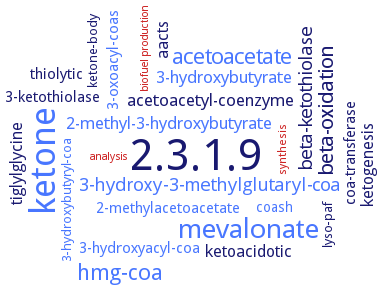2.3.1.9: acetyl-CoA C-acetyltransferase
This is an abbreviated version!
For detailed information about acetyl-CoA C-acetyltransferase, go to the full flat file.

Word Map on EC 2.3.1.9 
-
2.3.1.9
-
ketone
-
mevalonate
-
hmg-coa
-
acetoacetate
-
beta-oxidation
-
3-hydroxy-3-methylglutaryl-coa
-
beta-ketothiolase
-
2-methyl-3-hydroxybutyrate
-
3-hydroxybutyrate
-
acetoacetyl-coenzyme
-
ketoacidotic
-
ketogenesis
-
tiglylglycine
-
aacts
-
coa-transferase
-
2-methylacetoacetate
-
thiolytic
-
3-oxoacyl-coas
-
3-ketothiolase
-
3-hydroxyacyl-coa
-
coash
-
3-hydroxybutyryl-coa
-
lyso-paf
-
ketone-body
-
synthesis
-
analysis
-
biofuel production
- 2.3.1.9
- ketone
- mevalonate
- hmg-coa
- acetoacetate
-
beta-oxidation
- 3-hydroxy-3-methylglutaryl-coa
- beta-ketothiolase
- 2-methyl-3-hydroxybutyrate
- 3-hydroxybutyrate
-
acetoacetyl-coenzyme
-
ketoacidotic
-
ketogenesis
-
tiglylglycine
-
aacts
-
coa-transferase
- 2-methylacetoacetate
-
thiolytic
- 3-oxoacyl-coas
- 3-ketothiolase
- 3-hydroxyacyl-coa
- coash
- 3-hydroxybutyryl-coa
-
lyso-paf
-
ketone-body
- synthesis
- analysis
- biofuel production
Reaction
2 acetyl-CoA
=
Synonyms
2-methylacetoacetyl-CoA thiolase, 3-ketoacyl-CoA (T1)-like thiolase, 3-ketoacyl-CoA thiolase, 3-ketoacyl-coenzyme A thiolase, 3-oxothiolase, A1887, AACT, AACT1, AACT2, ACAT, ACAT1, ACAT2, ACCT, acetoacetyl CoA thiolase, acetoacetyl-CoA acetyltransferase, acetoacetyl-CoA C-acetyltransferase, acetoacetyl-CoA thiolase, acetoacetyl-CoA thiolase T2, acetyl coenzyme A thiolase, acetyl-CoA acetyltransferase, acetyl-CoA C-acetyltransferase, acetyl-CoA:N-acetyltransferase, acetyltransferase, acetyl coenzyme A, ACOAT, ACTRANS, AFUB_000550, AtoB, beta-acetoacetyl coenzyme A thiolase, beta-ketoacyl-CoA thiolase, beta-ketothiolase, CT, cytosolic acetoacetyl-CoA thiolase, cytosolic acetoacetyl-CoA thiolase 1, cytosolic acetoacetyl-CoA thiolase 2, ERG10, Erg10A, HFX_1022, HFX_1023, HFX_6003, HFX_6004, KACT, MmgA, Msed_0656, MSM-13 thiolase, OsAT1, phaA, ReH16_B0759, thiolase II, ThL, Tneu_0249, type II thiolase


 results (
results ( results (
results ( top
top






